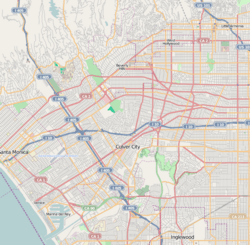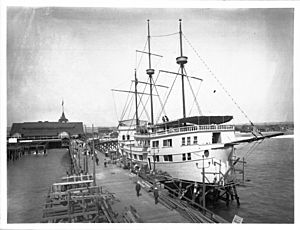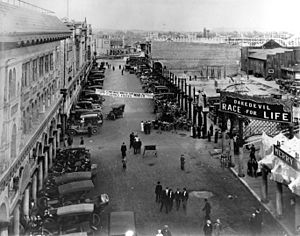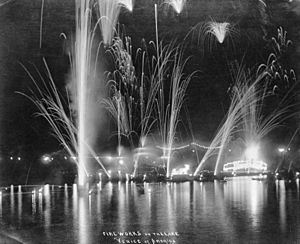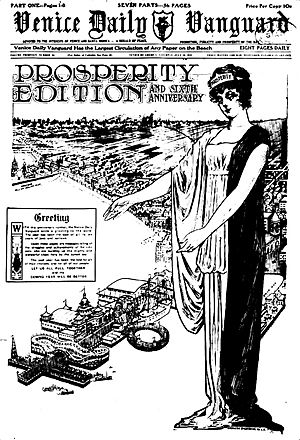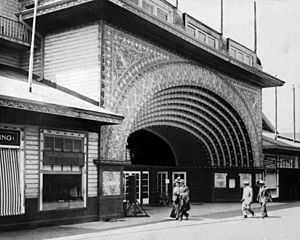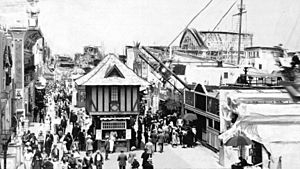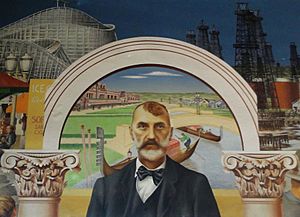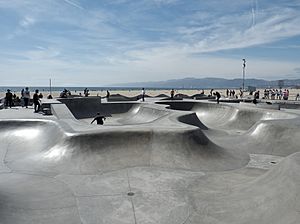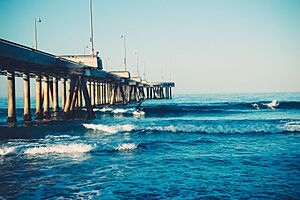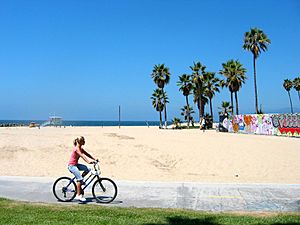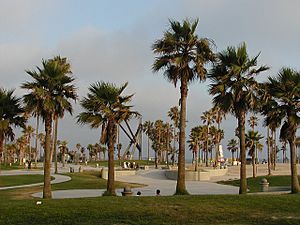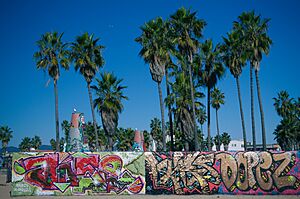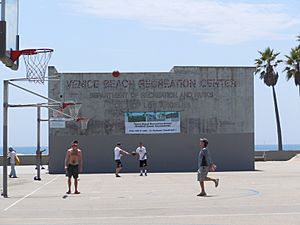Venice, Los Angeles facts for kids
Quick facts for kids
Venice
|
|
|---|---|
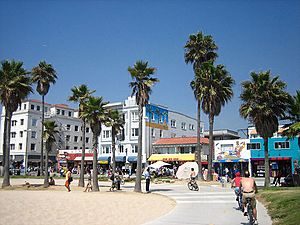
Venice Beach and Boardwalk, 2005
|
|
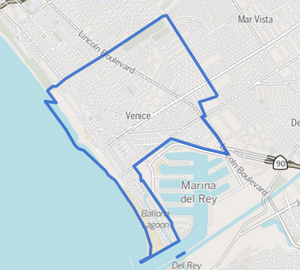
Venice boundaries
|
|
| Country | |
| State | |
| County | Los Angeles |
| City | Los Angeles |
| Founded as an independent city | 1905 |
| Merged with Los Angeles | 1926 |
| Named for | Venice, Italy |
| Area | |
| • Total | 3.1 sq mi (8 km2) |
| Elevation | 10 ft (3 m) |
| Population
(2023)
|
|
| • Total | 30,537 |
| Time zone | UTC-8 (PST) |
| • Summer (DST) | UTC-7 (PDT) |
| ZIP Codes |
90291, 90292
|
| Area codes | 310, 424 |
Venice is a lively neighborhood in Los Angeles, California. It's famous for its beautiful canals, sandy beach, and the exciting Ocean Front Walk. This pedestrian area is about 4 kilometers long. You can often see performers, fortune-tellers, and vendors there.
Venice was started in 1905 by a man named Abbot Kinney. He wanted to create a seaside resort town. It was its own city until 1926, when it became part of Los Angeles.
Contents
History of Venice
Early Days in the 19th Century
In 1839, the Mexican government gave a large area, including parts of what is now southern Venice, to some families. This land was known as La Ballona.
How Venice Was Founded
Venice was first called "Venice of America." It was founded in 1905 by a rich developer named Abbot Kinney. He wanted to build a beach resort town. It was about 22 kilometers west of Los Angeles. Kinney bought land near Santa Monica in 1891.
He imagined a seaside resort that looked like the famous city of Venice in Italy. To make this happen, Kinney dug many kilometers of canals. These canals helped drain the marshy land for homes. He also built a long pier with an auditorium and a unique ship-shaped restaurant. The main street had buildings with beautiful Venetian-style architecture.
When Venice of America opened, tourists arrived by train from Los Angeles. They could ride miniature trains and gondolas to explore the town. The most popular spot was Venice's long, gentle beach. Many people rented cottages or tents for their stays. By 1910, the town's population grew quickly, and it attracted thousands of tourists every weekend.
Fun at the Amusement Pier
Abbot Kinney added many exciting attractions to his pier. By 1910, there was a miniature railway, an aquarium, and several rides like the Virginia Reel and the Whip. He even hired aviators to perform daring stunts over the beach!
After Kinney passed away in 1920, the amusement pier burned down. However, his family quickly rebuilt it. The new pier was even better, with two roller coasters, a fun house, and other rides. By 1925, it was considered one of the best amusement piers on the West Coast. Hundreds of thousands of tourists visited on weekends.
Joining Los Angeles
By 1925, Venice faced challenges. Its roads, water, and sewage systems needed major repairs and upgrades. The town's leaders decided to hold an election to see if Venice should join Los Angeles. In November 1925, people voted to merge, and Venice officially became part of Los Angeles in 1926.
Oil Discovery
In 1929, oil was found south of Washington Street. This area is now known as the Marina Peninsula. Soon, hundreds of oil wells appeared, and drilling waste started to affect the waterways. This oil boom brought money to the community during the Great Depression. Most of these wells were closed by the 1970s.
A Time of Change
After Venice joined Los Angeles, the city didn't focus much on maintaining its unique features. Many of the canals were filled in and paved over. The neighborhood was seen as old-fashioned compared to the new car-focused areas.
By the 1950s, Venice was sometimes called the "Slum by the Sea" because of the lack of improvements. However, this also meant low rents. This attracted many European immigrants and young artists, poets, and writers. They created a vibrant counterculture scene.
Community Safety Efforts
In the past, Venice experienced challenges with local groups. However, over time, changes in the community and increased safety efforts helped reduce these issues. Many people moved to other areas, and the neighborhood became safer.
Housing in Venice
Building new homes in Venice can be difficult due to specific rules. Many of the houses are very old, built before current building regulations. Along Pacific Avenue, you can still see many apartment buildings from the early 1900s.
There are also people in Venice who do not have homes. In recent years, the city has opened shelters to help provide transitional housing for those in need.
Exploring Venice's Geography
Venice is located on the coast of Los Angeles County. It borders Santa Monica to the northwest. The neighborhood includes the Penmar Golf Course but not Venice High School. To the south, it reaches Ballona Creek.
Venice's Unique Areas
Venice Canal Historic District
The Venice Canal Historic District is a special part of Venice. It features several canals with charming bridges and homes. It reminds visitors of the original vision for "Venice of America."
Abbot Kinney Boulevard
Abbot Kinney Boulevard is a very popular street in Venice. It's filled with unique stores, restaurants, bars, and art galleries. In the late 1980s, this street was renamed to honor Abbot Kinney. This helped bring new businesses and a fresh look to the area.
Historic Post Office and Mural
The Venice Post Office is a historic building from 1939. It features a beautiful mural painted by artist Edward Biberman. The mural shows Abbot Kinney surrounded by beachgoers, workers, and oil derricks. It tells a story about Venice's past.
The post office closed in 2012. A movie producer bought the building, promising to preserve the mural and allow public access. The mural was carefully restored and is an important piece of Venice's history.
Venice's Walk Streets
Many homes in Venice have their main entrances on special pedestrian-only streets. Cars can only access these homes from alleys in the back. These "walk streets" create a unique, friendly neighborhood feel. However, like much of Los Angeles, Venice can have a lot of traffic on its main roads.
Venice Beach: A Famous Spot
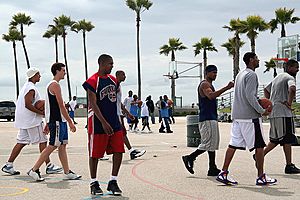
Venice Beach attracts millions of visitors each year. It's known for its unique culture and is a global tourist spot. The beach area includes the famous Venice Beach Boardwalk, Muscle Beach, and the Venice Beach Recreation Center. Here you can find courts for handball, paddle tennis, and volleyball. There's also a skate dancing plaza and a bike trail.
The basketball courts at Venice Beach are famous for their high-level streetball games. Many professional players have played or been discovered here.
In 2028, Venice Beach will be a host for the 2028 Summer Olympics. It will be the starting point for the triathlon, marathon, and road cycling events.
At the southern end of the beach is the Venice Fishing Pier. This long concrete pier first opened in 1964. It has been damaged by storms and rebuilt over the years. It reopened in May 2006 after repairs.
The Venice Breakwater is a popular local surf spot. It's an artificial barrier that helps create good waves for surfing.
Oakwood Neighborhood
Oakwood is a neighborhood located inland from the main tourist areas. It is known as one of the few historically African-American areas in West Los Angeles.
East of Lincoln Boulevard
East of Lincoln is another part of Venice, bordering Mar Vista. It has many small homes and apartments. You can also find Penmar Park and the Penmar Golf Course here.
A large apartment complex called Lincoln Place Apartment Homes has recently been renovated. It added new homes and updated existing ones, along with new facilities like a pool and fitness center.
Venice's Climate
Venice has a warm-summer Mediterranean climate. This means it has mild, wet winters and warm, dry summers. Temperatures are comfortable all year, with over 300 sunny days annually. Fall is often warmer than spring. Sometimes, morning fog appears in May and June, a phenomenon locals call "May Gray" or "June Gloom." This fog usually clears by noon.
Who Lives in Venice?
In 2008, about 40,885 people lived in Venice. The average age of residents was 35. Most residents (64.2%) were White, 21.7% were Latino, and 5.4% were African American. About 22.3% of people were born outside the United States.
Many adults in Venice have a four-year college degree. The average household income was $67,647 in 2008. Many people rent their homes (68.8%), while others own them. Recently, property values have increased due to technology companies like Google Inc. and Snap Inc. moving into the area.
Arts and Culture in Venice
Venice has always been a favorite place for creative artists. In the 1950s and 1960s, it became a hub for the Beat generation, with lots of poetry and art. This artistic spirit continues today.
Venice's Architecture
Venice was designed to look like Venice, Italy. You can see many early 1900s buildings with Italian Renaissance architecture. Along Windward Avenue, there are arched walkways over the sidewalks.
Famous designers Charles and Ray Eames had their offices in Venice. Many well-known architects, like Frank Gehry, have designed unique houses here. Sculptor Robert Graham also designed an art studio and home in Venice.
Art Scene in Venice
In the 1970s, performance artist Chris Burden created some of his early works in Venice. Many other famous artists, including Jean-Michel Basquiat and Dennis Hopper, had studios here. The Venice Beach boardwalk became a popular place for street performers in the 1980s and 1990s. You could see jugglers, breakdancers, acrobats, and comedians.
Venice Boardwalk Murals
The Venice Beach boardwalk is home to many colorful murals, including:
- Venice Kinesis (2010) by Rip Cronk
- Homage to a Starry Knight (1990) by Rip Cronk
- Endangered Species (1990) by Emily Winters
- Venice Beach (1990) by Rip Cronk
- Morning Shot (1991) by Rip Cronk (a portrait of musician Jim Morrison)
- Touch of Venice (2012) by Jonas aka "Never"
- Arnold Schwarzenegger (2013) by Jonas aka "Never"
- Luminaries of Pantheism (2015) by Levi Ponce
Venice Public Art Walls
The Venice Art Walls were built in 1961. They were part of the Venice Pavilion, a recreation center. These concrete walls became a popular spot for graffiti artists in the 1970s and 1980s. Many famous artists painted elaborate pieces here. Even though the pavilion was torn down, some of the walls were saved. They were restored in 2000, and artists can still paint there freely and legally today.
Music in Venice
Venice is where the famous rock band The Doors was formed in 1965. Jim Morrison and Ray Manzarek started the band here. Venice is also the birthplace of Jane's Addiction in the 1980s. Other bands from Venice, like ... Tendencies, played a mix of hardcore punk and thrash metal music.
Public Libraries
The Los Angeles Public Library has a branch in Venice called the Venice–Abbot Kinney Memorial Branch.
Street Performers and Unique Characters
Venice is well known for its street performers, also called buskers. One of the most famous is Harry Perry, a roller-skating guitar player wearing a turban. Other well-known performers include the Venice Beach Glass Man and Echoman.
Parks and Recreation
The Venice Beach Recreation Center offers many facilities. It has outdoor basketball, handball, paddle tennis, and volleyball courts. There are also children's play areas and chess tables. At the south end, you'll find the Muscle Beach outdoor gym. In 2009, a modern Venice Beach Skate Park opened on the sand. The Graffiti Walls are also nearby.
The Oakwood Recreation Center has an auditorium, baseball diamond, basketball courts, and a community room. It also has a football field, gym, picnic tables, and a soccer field.
There is also a dog park in Venice called the Westminster Off-Leash Dog Park.
Government and Services
Venice is a neighborhood within the city of Los Angeles. It is represented by District 11 on the Los Angeles City Council. The city of Los Angeles provides services like fire and police. There is also a Venice Neighborhood Council that gives advice to the City Council on local issues.
The Los Angeles Fire Department operates Station 63 in Venice. The Los Angeles Police Department serves the area from its Pacific Community Police Station and a beach sub-station. Lifeguard protection is provided by the Los Angeles County Lifeguards.
Education in Venice
Venice has several schools for students of all ages:
- Broadway Elementary School
- Animo Venice Charter High School
- Venice Skills Center
- Westminster Avenue Elementary School
- Coeur d'Alene Avenue Elementary School
- St. Mark's Catholic School
- Westside Leadership Magnet School
- Venice High School
Notable People from Venice
Many interesting people have lived in Venice:
- Fiona Apple, a singer-songwriter.
- Margot Robbie, an actress and producer.
- Jay Adams, a professional skateboarder.
- Millicent Borges Accardi, a poet and writer.
- Bryan Callen, a comedian and actor.
- Emilia Clarke, an actress.
- Zack de la Rocha, a musician.
- Tom Felton, an actor and musician.
- Sky Ferreira, a singer-songwriter and actress.
- John Lydon, also known as "Johnny Rotten," lead singer of the Sex Pistols.
- Milo Manheim, an actor known for the Disney Channel Original Movies, Zombies.
- Ian McShane, an actor.
- Betty Miller, the first woman to fly solo across the Pacific Ocean.
- Berniece Baker Miracle, author and half-sister of Marilyn Monroe.
- Casey Neistat, a filmmaker and YouTuber.
- Anna Paquin, an actress.
- Ronda Rousey, a mixed martial artist and actress.
- Joanie Sommers, a singer.
- Teena Marie, a singer-songwriter and producer.
Images for kids
-
Aerial view of Marina del Rey, Playa del Rey, Playa Vista, Venice Beach and Los Angeles International Airport
See also
 In Spanish: Venice (Los Ángeles) para niños
In Spanish: Venice (Los Ángeles) para niños


